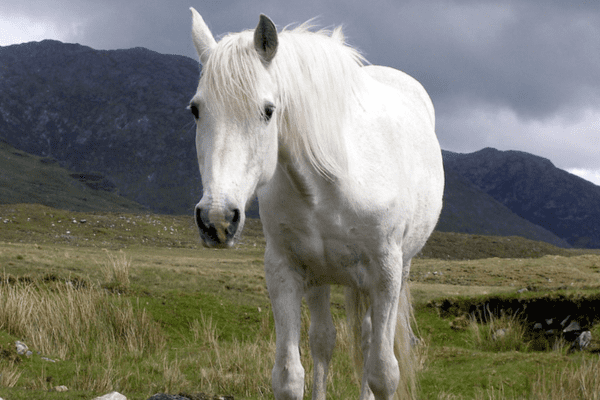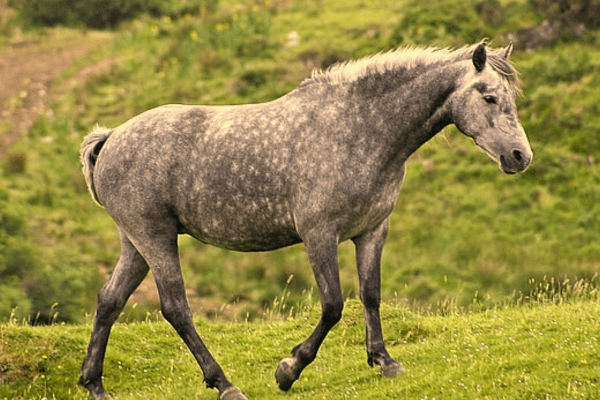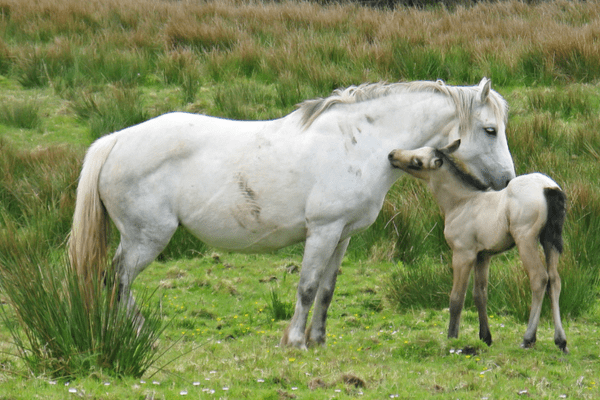The Connemara pony, a distinguished breed native to Ireland, is celebrated for its athletic prowess, versatile abilities, and congenial temperament. Excelling in the show arena, these ponies are a testament to equine elegance and competence. With characteristics that make them suitable for a diverse range of riders, the Connemara pony stands as a versatile and cherished partner in the equestrian world.
History:
The Connemara pony breed, inspired by Ireland’s Connemara region, boasts an illustrious past filled with stories of survival, refinement, and evolution.
Rugged Origins in Western Ireland
Connemara in County Galway is well known for its challenging, rugged landscapes. These conditions played a key role in developing the sturdy and long-lived nature of Connemara ponies, leading to their widespread acceptance across Ireland.
This breed emerged as its own distinct type in this harsh environment, where only those horses with superior strength and adaptability could thrive.
Viking and Irish Hobby Influence
History suggests a strong influence of Scandinavian ponies imported by Vikings onto Ireland on the development of Connemara Ponies.
Irish Hobbies were extinct breeds known for their speed and agility that may have played an influential role in shaping the Connemara pony lineage, with these breeds prevalent before 13th Century Ireland.
Spanish Armada Legend
An intriguing legend adds an exciting dimension to Connemara pony history. Legend has it that when Spain’s Armada ships were wrecked off Ireland in 1588, Andalusian horses from them crossed with local ponies, producing offspring which later gave rise to Connemara pony lines with greater elegance and refinement.
Introduction of Arabian, Hackney, and Thoroughbred Bloodlines
In the 18th century, Arabian blood was introduced into Connemara ponies to enhance their endurance and agility.
Crossbreeding of Hackneys and Thoroughbreds was also widely practiced, providing speed and additional refinement to the breed.
Preservation Efforts
Concerns were voiced as excessive crossbreeding began to dilute the distinct qualities of Connemara ponies, prompting efforts to preserve them as breed-specific breeds.
In 1923, The Connemara Pony Breeders’ Society was formed with a focus on protecting and improving Ireland’s native Connemara pony breed.
Establishment of the Society Stud Book in 1926 was an essential step toward safeguarding the breed’s purity and heritage.
Expansion and Recognition on a Global Scale
Over time, Connemara pony breeding programs have gained global acceptance, expanding beyond Ireland and Britain to encompass Europe, North America, Australasia and South Africa.
Since its debut, the Connemara Pony Breeders Society’s annual pony show has become a global event. Drawing together one of the largest collections of Connemara ponies ever assembled anywhere, this platform serves as an opportunity to buy or sell these esteemed animals.
Overall, the Connemara pony’s history is an intricate tapestry of survival, cultural exchanges and careful breeding practices. Originating in Western Ireland but now found across the globe as well, its genetic legacy stands as a symbol of Irish equestrian culture with strength, versatility and elegance at its core.
Characteristics:
The Connemara pony breed embodies grace and resilience in equal measure, defined by standards as rigorous as its native Irish landscape. Upheld by both Ireland’s Connemara Pony Breeders’ Society as well as Britain’s, these standards outline their physical and temperamental features which set this breed apart.
Stature and Structure
Connemara ponies typically stand between 128 cm (12.2 to 14.2 hands; 50 to 58 inches), providing both compact agility and robust strength in one package.
Your build should feature a strong back, sturdy loins, and well-muscled hindquarters, alluding to their inherent strength and endurance. Indicative of their respiratory capacity are their deep and wide ribcages.
Notably, they exhibit well-proportioned riding-type shoulders and necks designed to offer optimal control and comfort to riders, providing essential for both leisure and competitive riding. In addition, these horses possess distinctive head and limb structures which distinguish them from one another.
Distinctive Head and Limbs
Connemara ponies feature distinctively “pony-like” heads, broad between alert and kind eyes with deep jaws, refined jaws, and an accentuated cheekbone.
Ears of these ponies follow pony traits and are relatively short, adding expressive facial features. Legs show durability as strong, muscular upper legs, robust knees and hocks, medium-sized feet and medium-sized hoof pads provide stability and agility.


Gait and Movement
The Connemara pony exhibits a gait that is free, active, and fluid, reflecting its ease of movement and athletic ability, which is especially evident in its jumping prowess.
Color Spectrum
The breed standard recognizes various colors of pinto dogs: grey, black, brown, bay dun roan chestnut palomino and cream; however pinto patterns like piebald or skewbald do not fall within this scope of recognition.
Temperament and Intelligence
Connemara ponies are beloved companions, known for their intelligence and excellent temperament. Perfect companions in both competitive and recreational settings.
Horses known for their hardiness, endurance and natural ability to jump are popular choices among various equestrian disciplines.
Inspection and Grading
For an animal to be classified as grade 1 by the Connemara Pony Breeders’ Society, it must meet strict specifications. Ponies not entirely fulfilling this specification receive either grade 2 or 3 status.
In North America, the size range of Connemaras tends to be slightly larger, generally between 13 to 15 hands (52 to 60 inches, 132 to 152 cm).
Health and Genetics:
A key feature of the breed’s health management is testing foals for hoof wall separation disease, an autosomal recessive disorder. All foals go through testing as part of their registration process to ensure healthy lineages.
Connemara pony remains a symbol of elegance and resilience equestrian performance, reflecting their Irish origins and rich heritage.
Temperament and Versatility:
The Connemara pony’s temperament and versatility is widely renowned. Famous for their gentle nature and intelligence, these ponies possess great aptitude for learning – which makes them particularly suitable for children or novice riders.
Furthermore, their agility and strength appeal to more advanced riders alike; all while remaining good-natured and easy to handle. These traits endear them to all types of equestrians of all ages alike.
Connemara ponies are well-renowned for their versatility. While originally used for farming and transportation in Ireland’s harsh terrain, today they excel in various disciplines including show jumping, dressage and eventing competitions – often outperforming larger breeds in them!


Cultural Significance:
Culturally, the Connemara pony occupies a special place in Irish heritage and folklore. It stands as a symbol of resilience and adaptability – qualities highly prized in Irish folklore and stories.
Established in 1923, the Connemara Pony Breeders’ Society plays an essential role in upholding breed standards while spreading their qualities worldwide through annual shows and festivals like Connemara Pony Festival which celebrate this special breed and draw enthusiasts and breeders worldwide.

